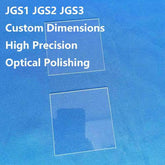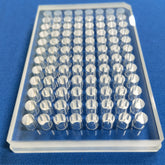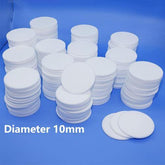How to Enhance Thermal Shock Resistance in Quartz Plates Processing?
The exceptional thermal shock resistance of quartz plates constitutes a critical property enabling their widespread utilization in demanding high-temperature and high-precision operational environments. Thermal shock resistance denotes the capacity of a material to withstand fracture and structural degradation when subjected to rapid thermal transients. Achieving superior thermal shock resistance in quartz plates requires comprehensive optimization across several critical dimensions, including material selection criteria, processing methodologies, and post-processing treatments. This analysis will examine in detail the technical approaches for enhancing the thermal shock performance of quartz plates.
1. Material selection and purity control
Quartz plates are primarily composed of silicon dioxide (SiO2), whose purity exerts a direct influence on their inherent physical and chemical properties. High-purity quartz exhibits an inherently low coefficient of thermal expansion, high thermal conductivity, and exceptional chemical stability, which collectively constitute the fundamental basis for its superior thermal shock resistance.
(1) The use of high-purity quartz raw materials has been shown to have a significant impact on minimizing the influence of impurities on the material properties. The presence of impurities can result in stress concentration at specific points and reduced thermal shock resistance.
(2) It is essential to ensure the uniformity of the microstructure of quartz materials and to avoid internal defects such as grain boundary defects or bubbles. Defects such as these can become stress concentration points and reduce thermal shock resistance.

2. Optimization of processing technology
The processing techniques used for quartz plates plays a critical role in determining their thermal shock resistance performance. The following outlines key processing parameters requiring optimization.
(1) Melting and molding Process
Quartz raw material must be subjected to high-temperature melting (typically exceeding 1700°C) to ensure internal structural homogeneity and densification.
(2) Cooling and Annealing
Post-forming components require precisely controlled cooling rates to minimize residual thermal stresses. Annealing treatments (generally at approximately 1000°C) are essential for eliminating processing-induced stress concentrations, thereby improving structural integrity.
(3) Cutting and Polishing
Implementation of advanced cutting techniques (e.g., laser or diamond tool machining) ensures precise cutting edges with minimized stress concentration. Subsequent precision polishing eliminates surface micro-cracks and structural defects, thereby enhancing thermal shock resistance.

3. Surface treatment and coating technology
The thermal shock resistance of quartz plates can be further enhanced through surface treatment and coating techniques.
(1) Surface treatment
The removal of surface microcracks and defects through chemical etching is an effective method of improving surface quality. Ion implantation technology is a highly effective process that improves the surface mechanical properties and enhances thermal shock resistance.
(2) Coating technology
Thermal barrier coatings, such as zirconia or alumina, are applied to the surface of quartz plates. This reduces the heat conduction rate and decreases thermal stress. In conditions of high-temperature oxidizing environment, an anti-oxidation coating is applied to protect the surface of the quartz plate and extend its service life.
4. Quality inspection and performance evaluation
To ensure the high thermal shock resistance of quartz plates, strict quality inspection and performance evaluation are required.
(1) Nondestructive test
Ultrasonic testing is used to detect internal flaws within quartz plates, including bubbles and cracks. Concurrently, X-ray imaging technology facilitates the assessment of structural homogeneity within the material.

(2) Thermal shock test
The quartz plates were subjected to cyclic tests in high and low temperature environments to evaluate their thermal shock resistance. The stress distribution of quartz plates at different temperatures was detected by stress analysis instruments.
(3) Micro-structure analysis
Micro-structure of quartz plates was conducted using scanning electron microscopy (SEM) to evaluate structural density and homogeneity. Furthermore, the coefficient of thermal expansion was precisely measured to verify compliance with the specifications for high thermal shock resistance applications.
Achieving high thermal shock resistance in quartz plates necessitates comprehensive optimization across multiple dimensions, including material selection, processing methodologies, and surface engineering techniques. Through implementing stringent control over raw material purity, refining processing parameters, and establishing rigorous quality tests, the thermal shock resistance can be substantially improved, thereby ensuring compatibility with demanding high-temperature and high-precision operational environments. Future advancements in material science and processing technologies are expected to further enhance the thermal shock performance of quartz components, enabling reliable performance across an expanding range of advanced applications.






